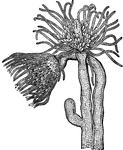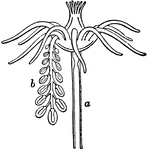Clipart tagged: ‘tubularia’

Tubularia coronata
"The Tubularidae are a family of hydroid polypes are for the most part social animals, frequently possessing…

Sertularia
Sertularia are members of the Protista kingdom. It is an example of another group of the hyroid zoophytes,…

Sertularia
Sertularia are members of the Protista kingdom. It is an example of another group of the hyroid zoophytes,…

Sertularia
Sertularia are members of the Protista kingdom. This is an example of the egg-producing gonophore.

Tubularia
Tubularia are members of the Protista kingdom. The pipe-coralline (Tubularia) is an example of another…

Tubularia Indivisa
"A single hydriform person a bearing a stalk carrying numerous degenerate medusiform persons or sporosacs…